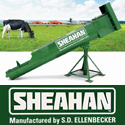 |
 |

|
|
|
Ohio Ag News Headlines |
 |
Tips for Successful Spring Forage Establishment
Ohio Ag Connection - 04/11/2024
As soil temperatures rise and the threat of morning frosts diminishes, the spring season presents an ideal opportunity for forage establishment. However, with limited planting windows and a plethora of tasks to attend to, maximizing planting opportunities becomes essential for success. Here are some key considerations to improve the chances of a successful spring forage establishment:
Soil Fertility and pH: Lay the groundwork for healthy forages by ensuring optimal soil conditions. Adequate soil fertility, characterized by sufficient available nutrients, is crucial for robust forage growth. Additionally, maintaining an appropriate soil pH level facilitates nutrient uptake by the plants. Refer to reputable soil fertility recommendations, such as the Tri-state Soil Fertility Recommendations, to guide your fertilization practices.
Seed Selection: Choose high-quality forage seed varieties that are well-suited to your region and intended use. Consider factors such as adaptability to local climate conditions, disease resistance, and desired forage characteristics. Investing in premium seed ensures a strong foundation for successful forage establishment.
Planting Timing: Capitalize on narrow planting windows by carefully timing your forage planting. Monitor soil temperatures and weather forecasts to identify optimal planting conditions. Aim to plant when soil temperatures are conducive to seed germination and when the risk of frost is minimal. Seizing favorable weather conditions maximizes the likelihood of successful establishment.
Seeding Rate and Depth: Adhere to recommended seeding rates and planting depths to optimize seed-to-soil contact and promote uniform germination. Ensure proper seed placement by adjusting seeding equipment accordingly. Proper seed placement enhances seedling emergence and establishment, setting the stage for vigorous forage growth.
Weed Control: Implement effective weed control measures to minimize competition for resources and space. Preemptive weed management strategies, such as pre-emergent herbicide applications or timely cultivation, help suppress weed populations and promote forage growth. Early weed intervention prevents weed infestations from stifling newly established forages.
Monitoring and Management: Stay vigilant throughout the establishment process by monitoring forage stands regularly. Assess plant emergence, growth rates, and overall stand density to identify any potential issues promptly. Implement appropriate management practices, such as irrigation or fertility adjustments, to address any emerging challenges and optimize forage growth.
By prioritizing soil fertility, selecting suitable seed varieties, timing planting activities, and implementing effective weed control and management strategies, producers can enhance the success of spring forage establishment efforts. With careful planning and attention to detail, spring-planted forages can thrive and contribute to sustainable livestock production systems.
|
 |


|
 |
|
Copyright © 2024 - Farms.com. All Rights Reserved. |
 |
|